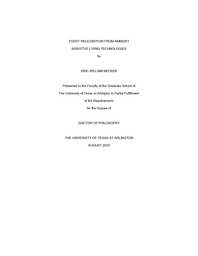
ATTENTION: The works hosted here are being migrated to a new repository that will consolidate resources, improve discoverability, and better show UTA's research impact on the global community. We will update authors as the migration progresses. Please see MavMatrix for more information.
Show simple item record
| dc.contributor.author | Becker, Eric William | en_US |
| dc.date.accessioned | 2010-11-01T21:28:56Z | |
| dc.date.available | 2010-11-01T21:28:56Z | |
| dc.date.issued | 2010-11-01 | |
| dc.date.submitted | January 2010 | en_US |
| dc.identifier.other | DISS-10760 | en_US |
| dc.identifier.uri | http://hdl.handle.net/10106/5141 | |
| dc.description.abstract | As the population ages and technology advances, a need exists for creating ambient intelligent systems to be placed within the home environment. Attitudes towards technology have been changing, and home monitoring is now considered a less expensive and desirable alternative. Ideally, such systems should be small, wireless, and take the minimum of effort and cost to install and place within the home. In order to detect human activity in an assistive environment, key questions about the construction and operation of the technology and methods needed to detect that activity. To that end, a computational framework has been created inside an apartment testbed combining a variety of algorithms, tools, and methods that support an assistive living apartment using Wireless Sensor Networks and other devices and sensors | en_US |
| dc.description.sponsorship | Makedon, Fillia | en_US |
| dc.language.iso | en | en_US |
| dc.publisher | Computer Science & Engineering | en_US |
| dc.title | Event Recognition From Ambient Assistive Living Technologies | en_US |
| dc.type | Ph.D. | en_US |
| dc.contributor.committeeChair | Makedon, Fillia | en_US |
| dc.degree.department | Computer Science & Engineering | en_US |
| dc.degree.discipline | Computer Science & Engineering | en_US |
| dc.degree.grantor | University of Texas at Arlington | en_US |
| dc.degree.level | doctoral | en_US |
| dc.degree.name | Ph.D. | en_US |
Files in this item
- Name:
- Becker_uta_2502D_10760.pdf
- Size:
- 2.990Mb
- Format:
- PDF
This item appears in the following Collection(s)
Show simple item record


